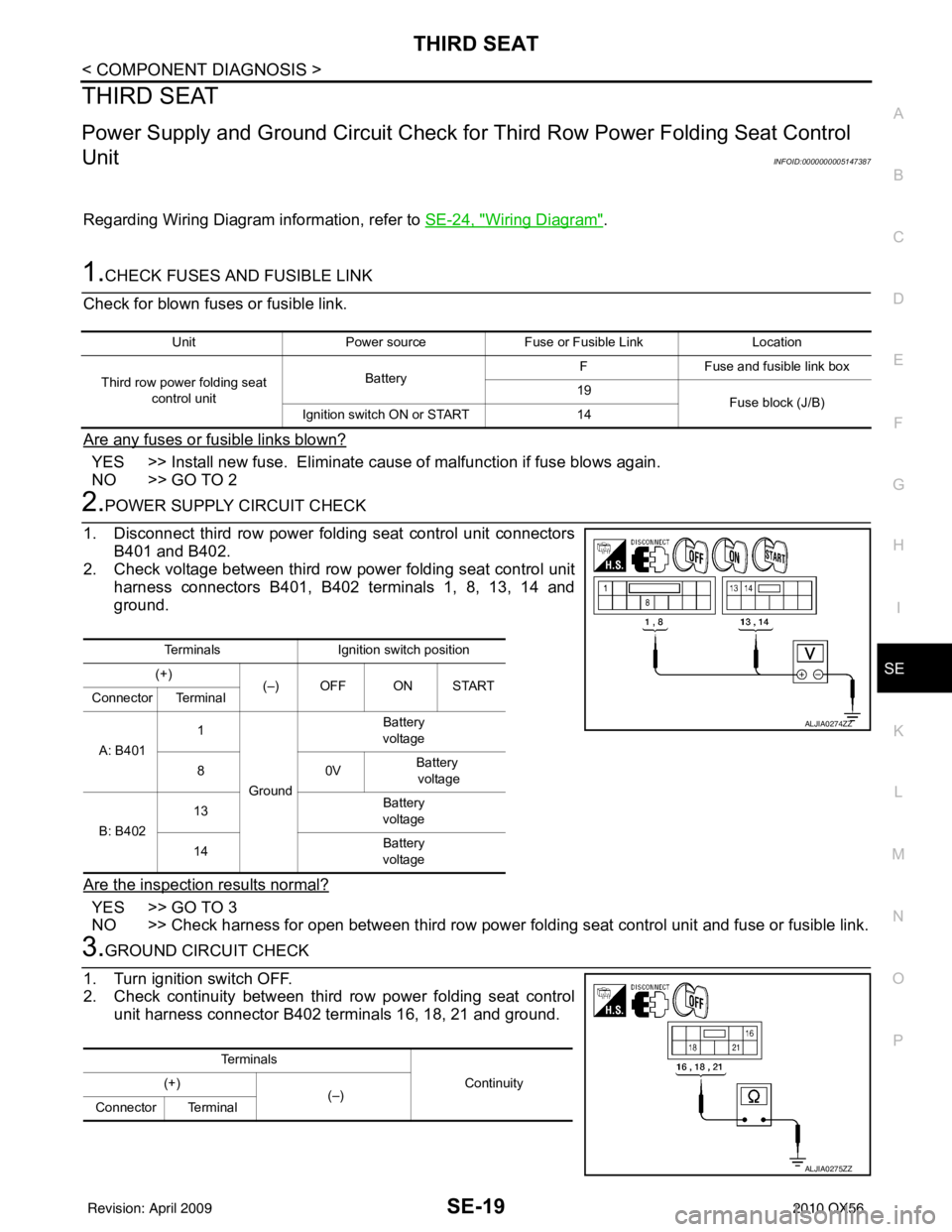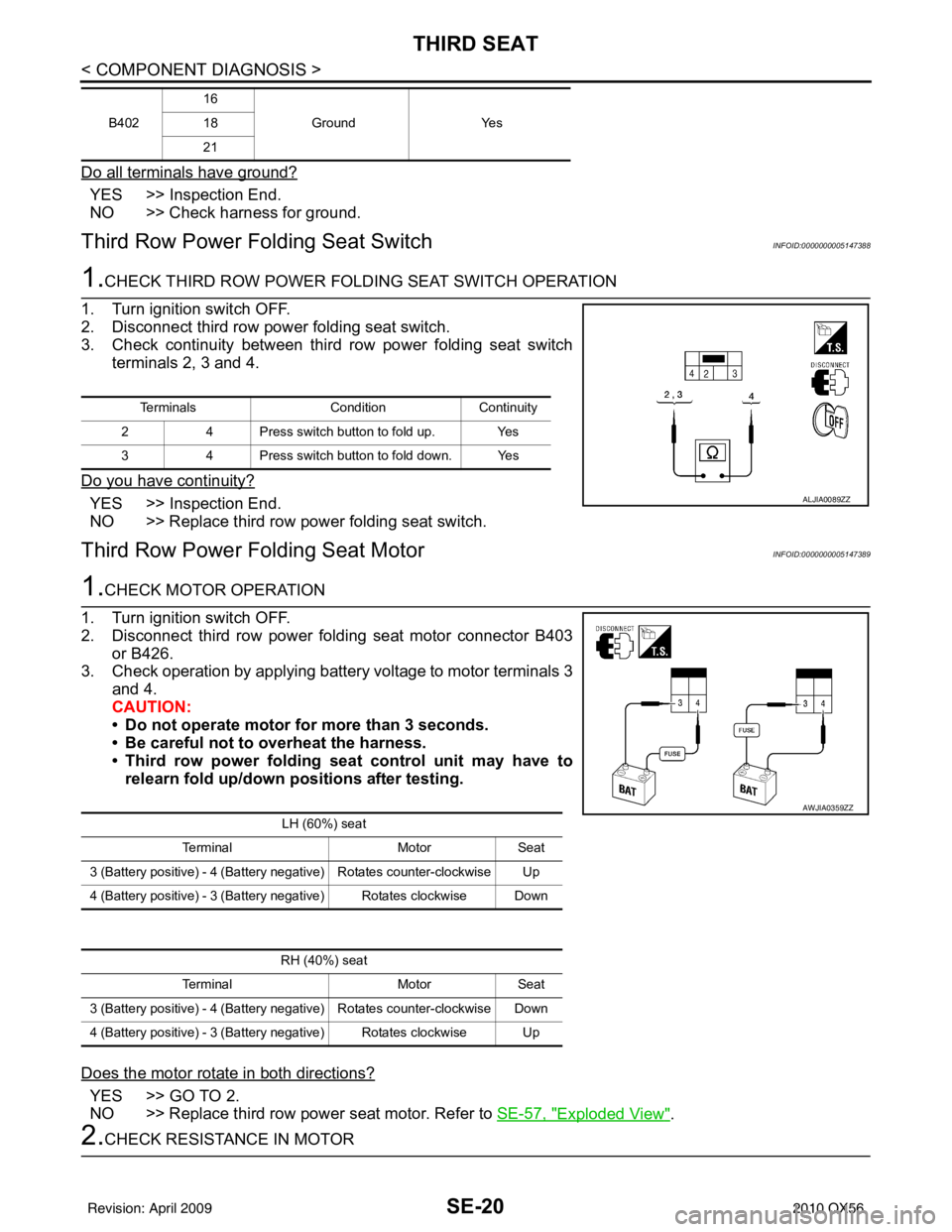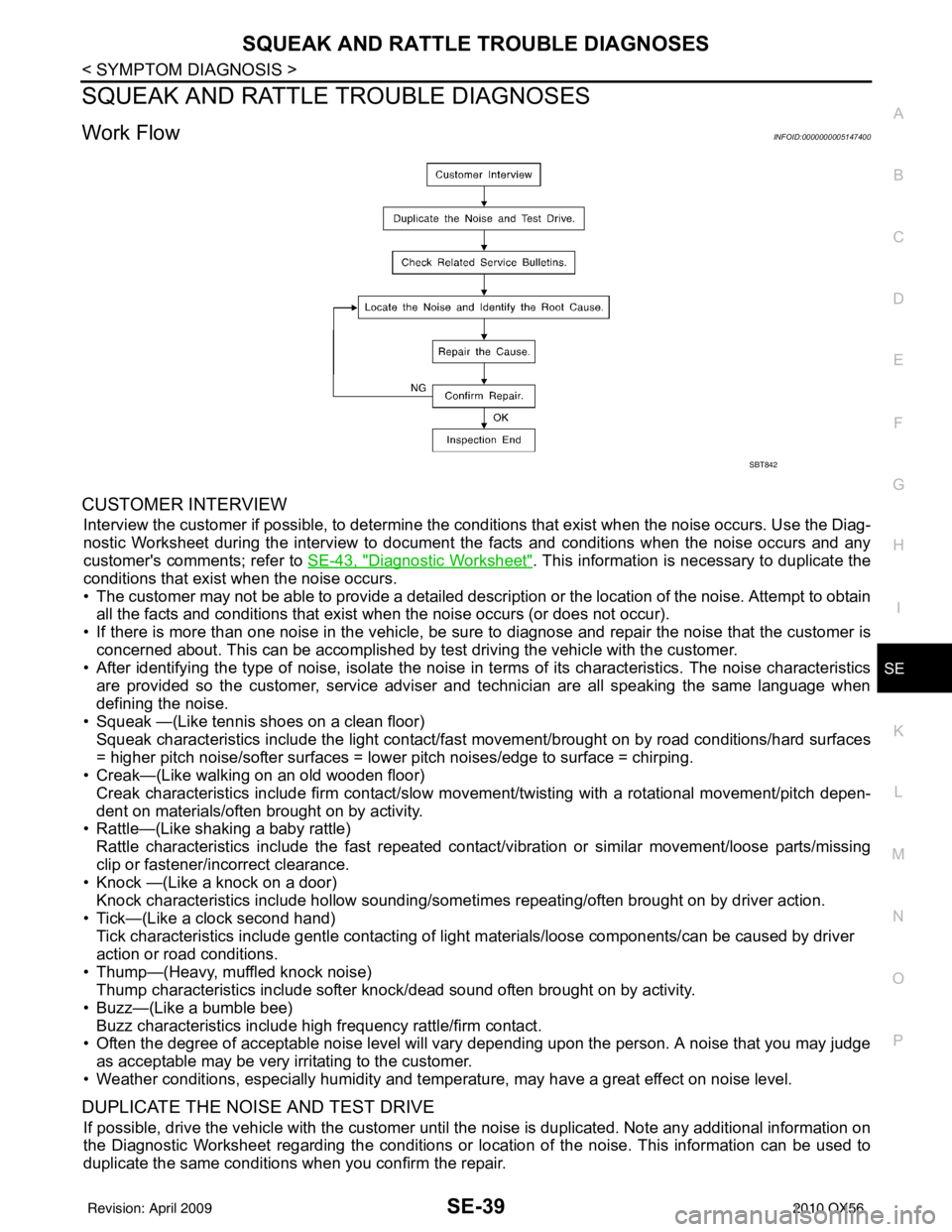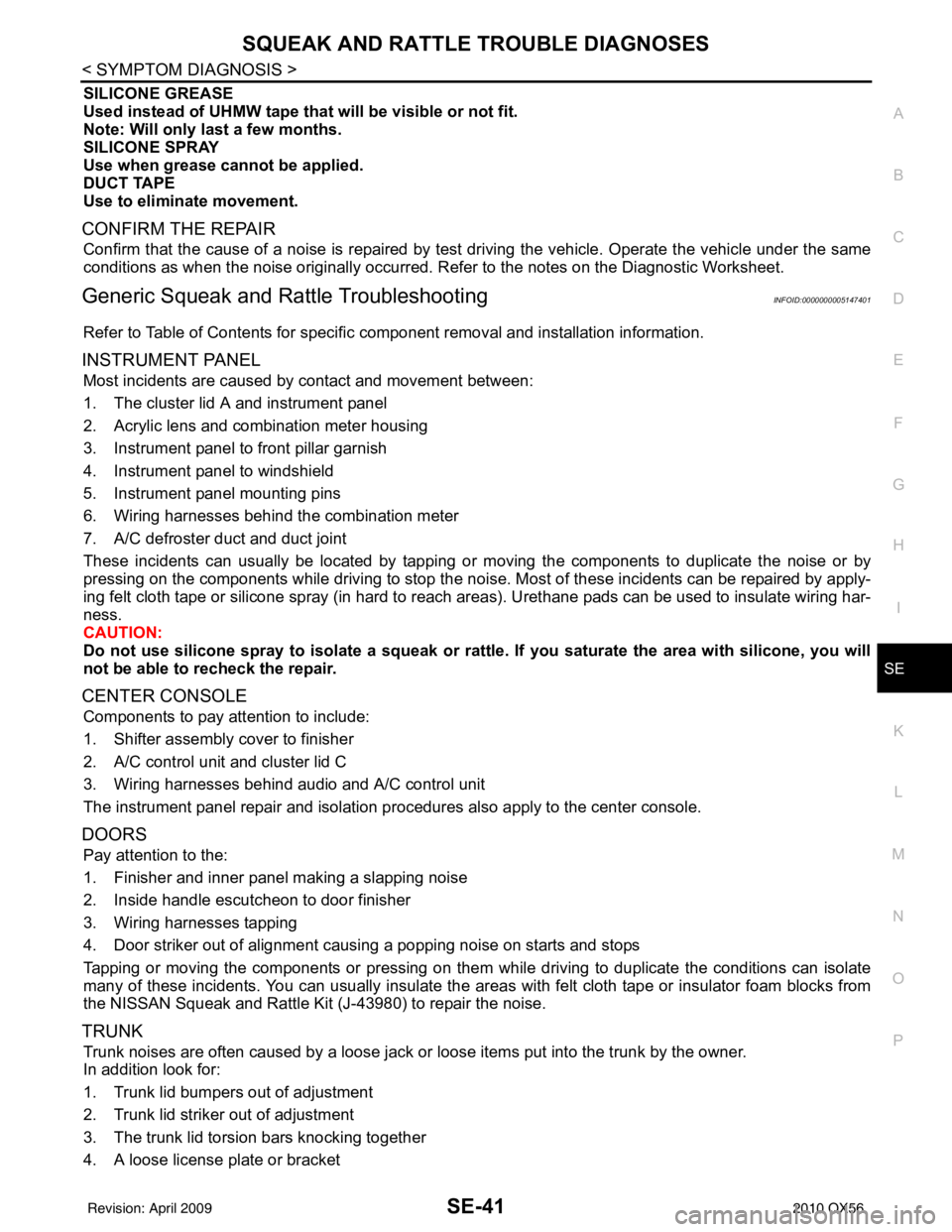2010 INFINITI QX56 lock
[x] Cancel search: lockPage 3233 of 4210

SCS-1
SUSPENSION
C
DF
G H
I
J
K L
M
SECTION SCS
A
B
SCS
N
O PCONTENTS
SUSPENSION CONTROL SYSTEM
BASIC INSPECTION ....... .............................3
DIAGNOSIS AND REPAIR WORKFLOW ..... .....3
Work Flow ........................................................... ......3
FUNCTION DIAGNOSIS ...............................5
SUSPENSION CONTROL SYSTEM .............. .....5
System Diagram .................................................. ......5
System Description ...................................................5
Component Parts Location ........................................6
Component Description .............................................6
DIAGNOSIS SYSTEM (SUSPENSION CON-
TROL UNIT) .........................................................
7
CONSULT-III Function ..............................................7
COMPONENT DIAGNOSIS ..........................9
C1801 VEHICLE HEIGHT SENSOR .............. .....9
Description .......................................................... ......9
DTC Logic .................................................................9
Diagnosis Procedure ................................................9
C1802 COMPRESSOR RELAY .........................10
Description ..............................................................10
DTC Logic ...............................................................10
Diagnosis Procedure ..............................................10
C1803 EXHAUST SOLENOID ...........................11
Description ..............................................................11
DTC Logic ...............................................................11
Diagnosis Procedure ..............................................11
C1804 HEIGHT ADJUSTING MALFUNCTION
(COMPRESSOR) ............................................ ....
12
Description .......................................................... ....12
DTC Logic ...............................................................12
Diagnosis Procedure ..............................................12
C1805 HEIGHT ADJUSTING MALFUNCTION
(EXH SOLENOID) ..............................................
13
Description ........................................................... ....13
DTC Logic ................................................................13
Diagnosis Procedure ..............................................13
C1806 VEHICLE HEIGHT SENSOR LOCK-
ING MALFUNCTION .........................................
14
Description ........................................................... ....14
DTC Logic ................................................................14
Diagnosis Procedure ...............................................14
C1807 SENSOR 5V MALFUNCTION ...............15
Description ...............................................................15
DTC Logic ................................................................15
Diagnosis Procedure ..............................................15
C1808 INTEGRAL TIME MALFUNCTION
SUPPLYING AIR ...............................................
16
Description ...............................................................16
DTC Logic ................................................................16
Diagnosis Procedure ..............................................16
POWER SUPPLY AND GROUND CIRCUIT ....17
SUSPENSION CONTROL UNIT ................................17
SUSPENSION CONTROL UNI T : Diagnosis Pro-
cedure .................................................................. ....
17
SUSPENSION AIR COMPRESSOR ..........................17
SUSPENSION AIR COMPRESSOR : Diagnosis
Procedure ............................................................ ....
17
HEIGHT SENSOR .................................................. ....18
HEIGHT SENSOR : Diagnosis Procedure ..............18
COMPRESSOR MOTOR RELAY .....................20
Description ...............................................................20
Component Function Check ....................................20
Diagnosis Procedure ...............................................20
HEIGHT SENSOR SIGNAL CIRCUIT ...............23
Description ...............................................................23
Component Function Check ....................................23
Diagnosis Procedure ...............................................23
Revision: April 20092010 QX56
Page 3246 of 4210

SCS-14
< COMPONENT DIAGNOSIS >
C1806 VEHICLE HEIGHT SENSOR LOCKING MALFUNCTION
C1806 VEHICLE HEIGHT SENSOR LOCKING MALFUNCTION
DescriptionINFOID:0000000005148166
The vehicle height sensor operates on a 5 volt referenc e signal from the suspension control unit. The suspen-
sion control unit also provides ground to the height sensor.
DTC LogicINFOID:0000000005148167
DTC DETECTION LOGIC
Diagnosis ProcedureINFOID:0000000005148168
1.CHECK HEIGHT SENSOR OPERATION
CONSULT-III
1. Turn ignition switch ON
2. Select "HEIGT SEN" of AIR LEVELIZER data monitor test item.
Is the HEIGHT SEN voltage within the given range?
YES >> Height sensor is operating normally.
NO >> Refer to SCS-23, "
Diagnosis Procedure".
DTC CONSULT-III Diagnostic item is detected when ... Probable malfunction location
C1806 VEHICLE HEIGHT SEN-
SOR LOCKING MAL-
FUNCTION Output sensor voltage variation
±0.02V is more
than 100 seconds when vehicle height range is
normal. • Height sensor power/ground supply. Refer to
SCS-18, "
HEIGHT SENSOR : Diagnosis
Procedure".
• Charging system malfunction. Refer to CHG-
8, "Inspection Procedure".
HEIGHT SEN : 0.2V - 4.8V with no more than ± 0.02V
variation
Revision: April 20092010 QX56
Page 3267 of 4210
![INFINITI QX56 2010 Factory Service Manual SUSPENSION CONTROL UNITSCS-35
< ECU DIAGNOSIS >
C
DF
G H
I
J
K L
M A
B
SCS
N
O P
Compressor relay [C1802] • Driving transistor for compressor relay is OFF and monitor
voltage continues at a high le INFINITI QX56 2010 Factory Service Manual SUSPENSION CONTROL UNITSCS-35
< ECU DIAGNOSIS >
C
DF
G H
I
J
K L
M A
B
SCS
N
O P
Compressor relay [C1802] • Driving transistor for compressor relay is OFF and monitor
voltage continues at a high le](/manual-img/42/57032/w960_57032-3266.png)
SUSPENSION CONTROL UNITSCS-35
< ECU DIAGNOSIS >
C
DF
G H
I
J
K L
M A
B
SCS
N
O P
Compressor relay [C1802] • Driving transistor for compressor relay is OFF and monitor
voltage continues at a high level for more than 10 seconds.
• Driving transistor for compressor relay is ON and monitor voltage continues at a low level for more than 5 seconds. SCS-10, "DiagnosisProcedure".
Exhaust solenoid [C1803] • Driving transistor for exhaust valve solenoid is OFF and
monitor voltage continues at a high level for more than 10
seconds.
• Driving transistor for exhaust valve solenoid is ON and mon- itor voltage continues at a low level for more than 5 seconds. SCS-11,
"DiagnosisProcedure".
Vehicle height adjusting malfunc-
tion (compressor)[C1804] Continuous compressor relay ON time is more than 120 sec-
onds. SCS-12,
"DiagnosisProcedure".
Vehicle height adjusting malfunc-
tion (exhaust solenoid)[C1805] Continuous exhaust valve solenoid ON time is more than 120
seconds. SCS-13,
"DiagnosisProcedure".
Vehicle height sensor locking mal-
function [C1806] Output sensor voltage variation
±0.02V is more than 100 sec-
onds when vehicle height range is normal. SCS-14, "
Diagnosis Proce-
dure".
Sensor 5V malfunction [C1807] Sensor reference voltage is less than 0.8V or more than 6V for
20 seconds. SCS-15,
"DiagnosisProcedure"
Integral time malfunction by sup-
plying air [C1808]A suspension air compressor ON request has been in effect
for 180 seconds and the suspension air compressor has not
activated during that time. SCS-16,
"DiagnosisProcedure".
Revision: April 20092010 QX56
Page 3291 of 4210

THIRD SEATSE-19
< COMPONENT DIAGNOSIS >
C
DE
F
G H
I
K L
M A
B
SE
N
O P
THIRD SEAT
Power Supply and Ground Circu it Check for Third Row Power Folding Seat Control
Unit
INFOID:0000000005147387
Regarding Wiring Diagram information, refer to SE-24, "Wiring Diagram".
1.CHECK FUSES AND FUSIBLE LINK
Check for blown fuses or fusible link.
Are any fuses or fusible links blown?
YES >> Install new fuse. Eliminate cause of malfunction if fuse blows again.
NO >> GO TO 2
2.POWER SUPPLY CIRCUIT CHECK
1. Disconnect third row power folding seat control unit connectors B401 and B402.
2. Check voltage between third row power folding seat control unit harness connectors B401, B402 terminals 1, 8, 13, 14 and
ground.
Are the inspection results normal?
YES >> GO TO 3
NO >> Check harness for open between third row power folding seat control unit and fuse or fusible link.
3.GROUND CIRCUIT CHECK
1. Turn ignition switch OFF.
2. Check continuity between third row power folding seat control unit harness connector B402 terminals 16, 18, 21 and ground.
Unit Power source Fuse or Fusible Link Location
Third row power folding seat control unit Battery
F
Fuse and fusible link box
19 Fuse block (J/B)
Ignition switch ON or START 14
TerminalsIgnition switch position
(+) (–) OFF ON START
Connector Terminal
A: B401 1
Ground Battery
voltage
80 VBattery
voltage
B: B402 13
Battery
voltage
14 Battery
voltage
ALJIA0274ZZ
Te r m i n a l s
Continuity
(+)
(–)
Connector Terminal
ALJIA0275ZZ
Revision: April 20092010 QX56
Page 3292 of 4210

SE-20
< COMPONENT DIAGNOSIS >
THIRD SEAT
Do all terminals have ground?
YES >> Inspection End.
NO >> Check harness for ground.
Third Row Power Folding Seat SwitchINFOID:0000000005147388
1.CHECK THIRD ROW POWER FOLDING SEAT SWITCH OPERATION
1. Turn ignition switch OFF.
2. Disconnect third row power folding seat switch.
3. Check continuity between third row power folding seat switch terminals 2, 3 and 4.
Do you have continuity?
YES >> Inspection End.
NO >> Replace third row power folding seat switch.
Third Row Power Folding Seat MotorINFOID:0000000005147389
1.CHECK MOTOR OPERATION
1. Turn ignition switch OFF.
2. Disconnect third row power folding seat motor connector B403 or B426.
3. Check operation by applying battery voltage to motor terminals 3
and 4.
CAUTION:
• Do not operate motor for more than 3 seconds.
• Be careful not to overheat the harness.
• Third row power folding seat control unit may have to
relearn fold up/down positions after testing.
Does the motor rotate in both directions?
YES >> GO TO 2.
NO >> Replace third row power seat motor. Refer to SE-57, "
Exploded View".
2.CHECK RESISTANCE IN MOTOR
B40216
Ground Yes
18
21
Terminals Condition Continuity
2 4 Press switch button to fold up. Yes
3 4 Press switch button to fold down. Yes
ALJIA0089ZZ
LH (60%) seat
Terminal MotorSeat
3 (Battery positive) - 4 (Battery negative) Rotates counter-clockwise Up
4 (Battery positive) - 3 (Battery negative) Rotates clockwise Down
AWJIA0359ZZ
RH (40%) seat
Terminal MotorSeat
3 (Battery positive) - 4 (Battery negative) Rotates counter-clockwise Down
4 (Battery positive) - 3 (Battery negative) Rotates clockwise Up
Revision: April 20092010 QX56
Page 3311 of 4210

SQUEAK AND RATTLE TROUBLE DIAGNOSESSE-39
< SYMPTOM DIAGNOSIS >
C
DE
F
G H
I
K L
M A
B
SE
N
O P
SQUEAK AND RATTLE TROUBLE DIAGNOSES
Work FlowINFOID:0000000005147400
CUSTOMER INTERVIEW
Interview the customer if possible, to determine the conditions that exist when the noise occurs. Use the Diag-
nostic Worksheet during the interv iew to document the facts and conditions when the noise occurs and any
customer's comments; refer to SE-43, "
Diagnostic Worksheet". This information is necessary to duplicate the
conditions that exist when the noise occurs.
• The customer may not be able to provide a detailed descr iption or the location of the noise. Attempt to obtain
all the facts and conditions that exist when the noise occurs (or does not occur).
• If there is more than one noise in the vehicle, be sure to diagnose and repair the noise that the customer is
concerned about. This can be accomplished by test driving the vehicle with the customer.
• After identifying the type of noise, isolate the noise in terms of its characteristics. The noise characteristics
are provided so the customer, service adviser and technician are all speaking the same language when
defining the noise.
• Squeak —(Like tennis shoes on a clean floor)
Squeak characteristics include the light contact/fast movement/brought on by road conditions/hard surfaces
= higher pitch noise/softer surfaces = lower pitch noises/edge to surface = chirping.
• Creak—(Like walking on an old wooden floor)
Creak characteristics include firm contact/slow mo vement/twisting with a rotational movement/pitch depen-
dent on materials/often brought on by activity.
• Rattle—(Like shaking a baby rattle)
Rattle characteristics include the fast repeated contac t/vibration or similar movement/loose parts/missing
clip or fastener/incorrect clearance.
• Knock —(Like a knock on a door)
Knock characteristics include hollow sounding/someti mes repeating/often brought on by driver action.
• Tick—(Like a clock second hand) Tick characteristics include gentle contacting of li ght materials/loose components/can be caused by driver
action or road conditions.
• Thump—(Heavy, muffled knock noise) Thump characteristics include softer k nock/dead sound often brought on by activity.
• Buzz—(Like a bumble bee)
Buzz characteristics include high frequency rattle/firm contact.
• Often the degree of acceptable noise level will vary depending upon the person. A noise that you may judge as acceptable may be very irritating to the customer.
• Weather conditions, especially humidity and temperature, may have a great effect on noise level.
DUPLICATE THE NOISE AND TEST DRIVE
If possible, drive the vehicle with the customer until the noise is duplicated. Note any additional information on
the Diagnostic Worksheet regarding the conditions or lo cation of the noise. This information can be used to
duplicate the same conditions when you confirm the repair.
SBT842
Revision: April 20092010 QX56
Page 3312 of 4210

SE-40
< SYMPTOM DIAGNOSIS >
SQUEAK AND RATTLE TROUBLE DIAGNOSES
If the noise can be duplicated easily during the test drive, to help identify the source of the noise, try to dupli-
cate the noise with the vehicle stopped by doing one or all of the following:
1) Close a door.
2) Tap or push/pull around the area where the noise appears to be coming from.
3) Rev the engine.
4) Use a floor jack to recreate vehicle “twist”.
5) At idle, apply engine load (electrical load, half-clutch on M/T model, drive position on A/T model).
6) Raise the vehicle on a hoist and hit a tire with a rubber hammer.
• Drive the vehicle and attempt to duplicate the conditions the customer states exist when the noise occurs.
• If it is difficult to duplicate the noise, drive the v ehicle slowly on an undulating or rough road to stress the
vehicle body.
CHECK RELATED SERVICE BULLETINS
After verifying the customer concern or symptom, chec k ASIST for Technical Service Bulletins (TSBs) related
to that concern or symptom.
If a TSB relates to the symptom, follo w the procedure to repair the noise.
LOCATE THE NOISE AND IDENTIFY THE ROOT CAUSE
1. Narrow down the noise to a general area.To help pinpoint the source of the noise, use a listening tool
(Chassis Ear: J-39570, Engine Ear: J-39565 and mechanic's stethoscope).
2. Narrow down the noise to a more specific area and identify the cause of the noise by:
• removing the components in the area that you suspect the noise is coming from.
Do not use too much force when removing clips and fasteners, otherwise clips and fasteners can be broken
or lost during the repair, resulting in the creation of new noise.
• tapping or pushing/pulling the component that you suspect is causing the noise.
Do not tap or push/pull the component with excessive force, otherwise the noise will be eliminated only tem-
porarily.
• feeling for a vibration with your hand by touching the component(s) that you suspect is (are) causing the
noise.
• placing a piece of paper between components that you suspect are causing the noise.
• looking for loose components and contact marks. Refer to SE-41, "
Generic Squeak and Rattle Troubleshooting" .
REPAIR THE CAUSE
• If the cause is a loose component, tighten the component securely.
• If the cause is insufficient clearance between components:
- separate components by repositioning or loos ening and retightening the component, if possible.
- insulate components with a suitable insulator such as urethane pads, foam blocks, felt cloth tape or urethane tape. A NISSAN Squeak and Rattle Kit (J-43980) is av ailable through your authorized NISSAN Parts Depart-
ment.
CAUTION:
Do not use excessive force as many components are constructed of plastic and may be damaged.
Always check with the Parts Department for the latest parts information.
The following materials are contained in the NISSAN Squeak and Rattle Kit (J-43980). Each item can be
ordered separately as needed.
URETHANE PADS [1.5 mm (0.059 in) thick]
Insulates connectors, harness, etc.
76268-9E005: 100 ×135 mm (3.94× 5.31 in)/76884-71L01: 60 ×85 mm (2.36 ×3.35 in)/76884-71L02: 15 ×25
mm (0.59× 0.98 in)
INSULATOR (Foam blocks)
Insulates components from contact. Can be used to fill space behind a panel.
73982-9E000: 45 mm (1.77 in) thick, 50 ×50 mm (1.97 ×1.97 in)/73982-50Y00: 10 mm (0.39 in) thick,
50× 50 mm (1.97 ×1.97 in)
INSULATOR (Light foam block)
80845-71L00: 30 mm (1.18 in) thick, 30 ×50 mm (1.18 ×1.97 in)
FELT CLOTH TAPE
Used to insulate where movemen t does not occur. Ideal for instrument panel applications.
68370-4B000: 15 ×25 mm (0.59× 0.98 in) pad/68239-13E00: 5 mm (0.20 in ) wide tape roll. The following
materials not found in the kit can also be used to repair squeaks and rattles.
UHMW (TEFLON) TAPE
Insulates where slight movement is present. Ideal for inst rument panel applications.
Revision: April 20092010 QX56
Page 3313 of 4210

SQUEAK AND RATTLE TROUBLE DIAGNOSESSE-41
< SYMPTOM DIAGNOSIS >
C
DE
F
G H
I
K L
M A
B
SE
N
O P
SILICONE GREASE
Used instead of UHMW tape that will be visible or not fit.
Note: Will only last a few months.
SILICONE SPRAY
Use when grease cannot be applied.
DUCT TAPE
Use to eliminate movement.
CONFIRM THE REPAIR
Confirm that the cause of a noise is repaired by test driving the vehicle. Operate the vehicle under the same
conditions as when the noise originally occurred. Refer to the notes on the Diagnostic Worksheet.
Generic Squeak and Rattle TroubleshootingINFOID:0000000005147401
Refer to Table of Contents for specific component removal and installation information.
INSTRUMENT PANEL
Most incidents are caused by contact and movement between:
1. The cluster lid A and instrument panel
2. Acrylic lens and combination meter housing
3. Instrument panel to front pillar garnish
4. Instrument panel to windshield
5. Instrument panel mounting pins
6. Wiring harnesses behind the combination meter
7. A/C defroster duct and duct joint
These incidents can usually be located by tapping or moving the components to duplicate the noise or by
pressing on the components while driving to stop the noi se. Most of these incidents can be repaired by apply-
ing felt cloth tape or silicone spray (in hard to reach areas). Urethane pads can be used to insulate wiring har-
ness.
CAUTION:
Do not use silicone spray to isolate a squeak or ra ttle. If you saturate the area with silicone, you will
not be able to recheck the repair.
CENTER CONSOLE
Components to pay attention to include:
1. Shifter assembly cover to finisher
2. A/C control unit and cluster lid C
3. Wiring harnesses behind audio and A/C control unit
The instrument panel repair and isolation pr ocedures also apply to the center console.
DOORS
Pay attention to the:
1. Finisher and inner panel making a slapping noise
2. Inside handle escutcheon to door finisher
3. Wiring harnesses tapping
4. Door striker out of alignment causing a popping noise on starts and stops
Tapping or moving the components or pressing on them while driving to duplicate the conditions can isolate
many of these incidents. You can usually insulate the ar eas with felt cloth tape or insulator foam blocks from
the NISSAN Squeak and Rattle Kit (J-43980) to repair the noise.
TRUNK
Trunk noises are often caused by a loose jack or loose items put into the trunk by the owner.
In addition look for:
1. Trunk lid bumpers out of adjustment
2. Trunk lid striker out of adjustment
3. The trunk lid torsion bars knocking together
4. A loose license plate or bracket
Revision: April 20092010 QX56